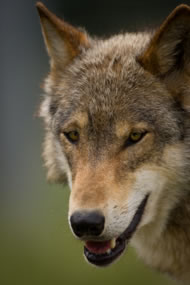“Beware the wolves of Chiantishire,” warned a recent Daily Mail headline. Tuscany’s “idyllic landscape of rolling fields and poplar-lined hills”, the article continued, which in the past “proved irresistible to the great, the good and the very rich”, have in recent months become “home to a savage predator – packs of marauding wolves which are growing increasingly brazen”. Politicians in Chianti-country, we are told, “have called on the government to take action. There are growing fears that the wolves could attack humans.”
Even by the Daily Mail’s usual standards of scaremongering, this scenario is pushing it. In spite of their mythically savage status, proven attacks on humans by wolves are very small in number: globally since 2000 there have only been around 20 confirmed attacks. By comparison, in an average year there are 26 deaths caused by domestic dogs in the United States alone. The risk to humans of an unprovoked attack by a wolf is minuscule in comparison, even taking into account the vastly greater number of dogs.
Exaggerated though this report is, there’s a grain of truth: wolves are on the increase, a conservation success story of sorts in some parts of Europe at least. Reintroduced colonies have been fanning out, faster than anticipated. In Italy there have even been occasional wolf sightings within 50km of Rome. In France a growing wolf population (which spread naturally across the Italian border) is now established in 14 departments. The wolves in these countries owe their survival to the strong conservationist lobby establishing protection in the face of cultures deeply committed to hunting. Even in more populated areas, wolves have made occasional appearances, with packs establishing in Eastern Germany and occasional sightings in the Netherlands and Belgium.
The Daily Mail article also contains another grain of truth. While this expansion holds very little threat to humans, the threat to livestock is obviously very real. In Italy it is estimated that 1,000 livestock were killed last year; in France in 2011 alone, wolves are thought to have killed 5,000 sheep; and in Spain’s Asturias region wolves killed 1% of the stock reared between 2000 and 2004.
In some front-line wolf territories there are considerable tensions in spite of huge efforts by conservationists to make protection work. In France a Wolf Plan, created in 2004, pays generous compensation for livestock killed by wolves and subsidises farmers to buy and train dogs (the Patou or Pyrenean mountain dog) that traditionally protected herds against wolves. But shepherds in the Alps are complaining that these dogs can attack tourists, causing more problems than they solve, and that wolves, losing their fear of humans, are becoming more menacing.
Environmentalists believe that wolves will not approach humans, and that livestock tended with properly trained dogs will not be attacked. They are sceptical too about how many livestock are actually killed by wolves and about the compensation claims. But views have become so polarised that in the French Alps the stand-off has been described as ferocious pastoral warfare.
We only have to look at the Daily Mail piece to see why these conflicts escalate so fast and why dialogue around wolves is so charged. The language is loaded with emotive terms describing wolves as ‘savage’, ‘marauding’ and ‘brazen’, and the expansion of their population as a campaign to expand their territory. These terms imply not just that wolves are natural predators but that they have a conscious, malign intent on humanity. This is the archaic symbolism of fairy tales, which emerged in earlier times and in wilder places where the harshness and savagery of Nature is as apparent as its blessings and where people exposed to this harshness (in which the wolves’ arbitrary depredations of their stock would figure large) would have good reason to imagine the ‘cruelty’ of Nature embodied in certain creatures.
Even though societies (even remote ones) are much better protected, connected and resourced, this ancient symbolism is easily reactivated. Indeed it plays a huge part in the ongoing persecution of wolves. When George Monbiot recently wrote about the treatment of wolves in Norway – a country that, although blessed with many wild and remote areas, has nevertheless hunted wolves to the point of extinction – he met with a barrage of accusations. At the forefront was the charge that Monbiot was a sentimental urbanite who simply didn’t understand the true malevolence of the wolf.
And wolves are not only laden with symbolism by their opponents: they are also heavily endowed with symbolic attributes by their supporters. This is not so obvious, but it is an important factor in why the stakes are so high on both sides. Of all species, wolves can, and do, scavenge, but they are primarily a hunting species needing to range far and wide in pursuit of both prey and mates. Wolves need space – vast, non-urbanised areas – and a healthy environment with ample big prey, as all top predators do. What’s at stake for conservationists isn’t just the survival of the species but the survival of wilderness, of unmanaged spaces big enough to sustain the wolf; in short, as close to an imagined natural state as it is possible to be. Recent research on their social structure, loyalty and sophisticated hunting communication has added hugely to the wolf’s charms, but fundamentally their charisma lies in their embodiment of Nature without human interference.
I understand the pull of this symbolism. I often choose my holiday destinations because of the presence of wolves in an area. Last summer I went to Transylvania, attracted by an environment that still supports top predators such as wolves and bears. Their existence signals that this environment is relatively pristine or at least tended in traditional low-impact ways. I didn’t see any wolves – indeed I didn’t even come across recent scats like I had in Poland’s Bialowieza Forest (another destination I chose for the presence of wolves). But in the remote Carpathians they never felt far away, their presence signalled by sheep tended in the tightest of tight groups by the traditional sheepdogs and always with a shepherd present who would warn off any tourist intent on approaching the dogs. These animals are not in the business of making friends. This is an environment where the wolf is present, a robust environment therefore, an environment where Nature is not dominated or controlled entirely by humans.
But if the wolf is valued because its presence implies Nature unsubdued, then suggestions of ‘managing’ wolf populations are inherently problematic. Management implies Nature on human terms. Of course, resistance to wolf management has some strong rational grounds because ‘management’ covers a multitude of sins. At its softest end, it can mean supporting traditional pastoral techniques like working with the dogs, and allowing farmers to fire warning shots, or even kill wolves that threaten their flocks. But at the other end, management can sometimes be used to justify wolf persecution. Monbiot has pointed out that this is not only the case in Norway but in Canada too, where the killing of wolves is explained as part of a management plan for caribou. In fact it appears the level of threat to caribou has been entirely exaggerated and is being used to support another agenda, namely the exploitation – and destruction – of the wolf’s environment.
It’s also hard not to feel repulsed by some of the language employed around ‘managing’ wolves. Some of the American states – even very enlightened ones like Minnesota – use the term ‘harvest’ for the sporadic culling of wolves. Sweden, which has just controversially given the go-ahead to the culling, repeatedly uses the expression ‘managing at sustainable levels’, even though the Swedish wolf population is already considerably reduced. In both cases these feel like euphemisms for – certainly in Sweden’s case – unjustified killing.
Yet if the wolf population grows, ‘management’ will have to be addressed; the fears are too deep, and the losses too painful for some rural communities. But to be acceptable, a new, less loaded language may have to be found. There needs to be a way of talking about wolves without succumbing either to scaremongering and ethnocentric notions of human management on one hand, or impossible ideals of prehuman wilderness on the other.
There are signs this is happening. Jean-Marc Moriceau, a wolf expert and the author of Man Versus Wolf: A 2,000-year War, has advanced the idea of a ‘wolf parliament’, bringing together shepherds, ecologists and government. That would require a new unfamiliar language around beasts, a language of needs, rights and interests, mitigation of harm, and negotiated settlements.
Management by another name need not be disastrous. Take Romania, which, with 3,000 wolves, has the largest numbers in Europe. It is one of the few European countries that don’t pay compensation for wolf kills. Nevertheless the wolf isn’t particularly persecuted there and it’s easy to see why. Flocks are never left untended. They move with shepherds and dogs in close and continuous attendance. Insofar as money comes in from wolves, it’s not from compensation or bounties. It’s from tourism drawn to the idea of remoteness.
Language describing what’s happening there, namely “low-impact human activity in areas where wolves still have stronghold”, may not have the emotional resonance of the old polarisations, but it might just have a much happier outcome.








